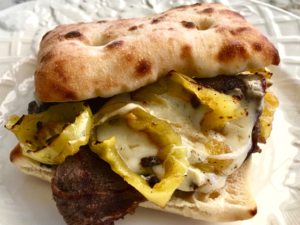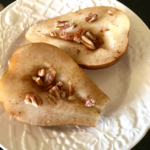
Get stories and expert advice on all things related to college and parenting.
Good nutrition is the foundation for feeling energetic, alert and strong, but eating well can be a challenge for college students who live off campus. They are at the mercy of student budgets, transportation limitations and novice (or nonexistent!) cooking skills. I know because I have seen my own two college-aged children struggle to prepare easy, healthy, satisfying and economical meals.
With a little direction and a few gentle reminders, you can help set your student up for comfort and happiness while living on their own. Here are my favorite go-to ideas for meals, plus suggestions for simple ingredients to have on hand when short on time and money.
There is no more wholesome food in my opinion than oatmeal. This is such an important staple item. It is undeniably healthy, easy to make, and so versatile. Milk or water added to ½ cup of oatmeal is heartwarming and delicious, especially when topped with fresh fruit, nuts or a spoonful of all natural peanut butter.
Low-fat multigrain waffles with all natural peanut butter and nuts or sliced banana is another treat for breakfast or as a healthy snack.
Use your ripe bananas wisely. By mashing a ripe banana and adding oatmeal and cinnamon, your kids can make delicious breakfast “cookies.” Just mash one banana for every ½ cup of uncooked oatmeal, sprinkle with cinnamon to taste, and mix together. Cook on a baking sheet in an oven preheated to 300 degrees for 10 minutes or until golden and slightly crisp.
 The pan, pot and baking sheet that you purchased for your students when they moved off campus are invaluable. It could not be easier to prepare an egg or a healthy version of a steak sandwich. My recipe for the Healthiest Steak Sandwich Ever is between 300 and 500 calories depending on the bread used and only takes 10 minutes to make. It’s not only delicious but a great source of iron.
The pan, pot and baking sheet that you purchased for your students when they moved off campus are invaluable. It could not be easier to prepare an egg or a healthy version of a steak sandwich. My recipe for the Healthiest Steak Sandwich Ever is between 300 and 500 calories depending on the bread used and only takes 10 minutes to make. It’s not only delicious but a great source of iron.
Heat a nonstick pan coated with cooking spray. Add steak and sliced fresh peppers (bell or hot peppers depending on your taste), season and stir occasionally. When steak is cooked through, add a slice of cheese. When melted, sandwich the steak, cheese and peppers between lightly toasted slices of your favorite bread or serve open-faced.
Here is a simple and versatile meal requiring just a few staple ingredients. It’s loaded with nutrients and so satisfying, especially on a cold day.
Ingredients:
Two tablespoons extra virgin olive oil
Two 14.5 oz. cans of cannellini beans (any canned bean is fine), rinsed and drained
Two 14.5 oz. cans of mixed vegetables (fresh or frozen will work, too)
One 28 oz. can of crushed tomatoes
7 cups (just under 2 quarts) low sodium/low fat chicken broth
1.5–2 cups water
One cup barley (located near rice and dry beans in the grocery store)
To taste: garlic powder, crushed red pepper flakes, salt and black pepper
Directions:
Heat oil in a large stock pot on low for one minute. Add tomatoes, mixed vegetables and beans. Sauté for 5 minutes, stirring occasionally. Add broth and water. Season as desired. Bring to a boil. Add barley and cook for an additional 30 minutes at a low-to-medium simmer, stirring occasionally.
This dish is packed with protein and can store for several days in the refrigerator. My kids enjoy dunking crusty Italian bread if available or some type of specialty cracker to add a little crunch. If your student has easy access to the grocery store, they can add fresh spinach or meat from a rotisserie chicken during the last few minutes of cooking. (Purchasing a rotisserie chicken is a great time saver. I recommend taking the skin off and adding the meat to a quick soup, sandwich or wrap.)
 A sweet treat
A sweet treatWe all want something sweet sometimes. Warmed Pear/Apple with Cinnamon and Nuts is my daughter’s favorite. This easy treat can be baked in the oven at 300 degrees for 10 minutes or microwaved for 2 minutes. Cut the fruit in half before cooking and sprinkle with cinnamon and chopped nuts. Bake or microwave accordingly and dessert is served.
When moving my children into their residences, we made sure to stock up on nonperishables that could easily fit into various recipes. My number one tip is to stock up on easy-to-store, healthy foods that don’t spoil such as canned beans and canned tomatoes. Suggest that your student opt for low sodium/low fat/low sugar foods with no artificial sweeteners. Here’s a shopping list your student may find useful.
Bananas
Apples
Clementines (in season)
Rolled oats (old-fashioned or quick)
Thin sliced sirloin steak for sandwiches. (The brand I use, Landis, comes in the freezer section and is a much better grade of meat than the typical boxed chip steak. It is 80 calories/4 grams of fat per slice.)
Sliced cheese (reduced fat)
Raw unsalted nuts
Cooking spray
Extra virgin olive oil
Low fat/low sodium chicken, beef or vegetable broth (available in cans, cartons or as a concentrate like “Better Than Bouillon”)
Frozen oven-baked fries (a much better alternative to regular french fries and easy enough for students to pop into the oven)
100 calorie bread thins or flatbreads for sandwiches
Jarred veggies such as roasted peppers in water
Salt, black pepper, crushed red pepper flakes, garlic powder, Italian seasoning, cinnamon